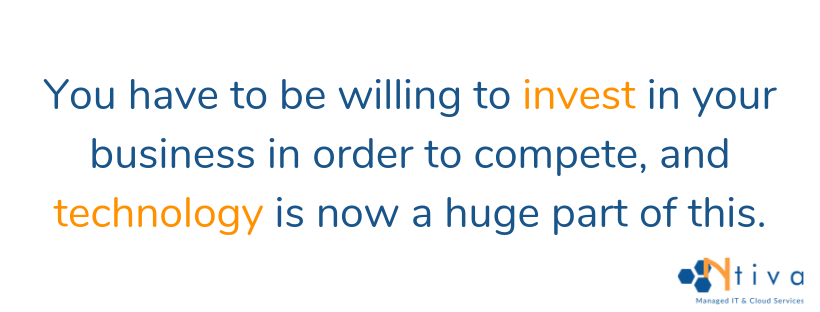The first telltale sign that outdated technology is killing your business – or if not killing it, at least stalling it – is the lack of business. You’re no longer growing, and your competition is surpassing you.
There’s no question that technology is a huge business enabler and that companies that embrace new tech are far more likely to succeed. We’re not necessarily talking about bleeding edge technology, in fact in many cases we’re simply talking about staying current as you’ll see below, but new solutions can definitely help move the dial.
Consumers Have High Expectations
Here’s a great example of what I mean.
I recently purchased a new home which means I’m interviewing moving companies, who more or less all offer the same service. Very competitive line of business, and the quotes coming in are all pretty similar.
But one moving company I spoke to has an app that you can download on your smartphone so you can track your move, managing the whole project from start to finish. You know who your project manager is, what vehicles they’re going to be providing, how the move is proceeding…all that data is being provided to me.
Consumers – who are your customers – are addicted to their personal tech and tend to have high expectations. The moving company knew they’d have an advantage over the competition by adopting this technology, even though their service - the hauling of boxes and furniture on and off a truck - is arguably pretty much the same as everyone else’s.
Signs of Outdated IT Systems
Proper support services don't exist. Something breaks, and you don't know who to reach out to? This is a bad sign.
Warranties have lapsed. If all of your servers and devices are on their last legs with no warranty to support them, you're in trouble!
No IT user policy. Devices should be updated and maintained properly. A solid IT user policy takes care of this.
Internal employee complaints. No one knows your systems better than your own employees. If they're complaining, it might be time to listen up.
What Do Outdated IT Systems Look Like?
From the IT side of things, when I first speak to a prospect over the phone or show up on site, outdated software and hardware is a glaring indicator that someone is not looking after the shop.
As a provider of IT services to all sorts of businesses, we run across this more times than I can count.
This usually means that proper support services are not in place, warranties have lapsed, there’s no IT user / acceptable use policy in place…all these are indicators that the business has been unable to keep up.
And if the LAN room is a mess of cables and looks more like a storage room, we start to suspect other items have slipped, from outdated backup solutions to limited cyber security protection.
While all of this may seem to some extent hidden, you can be sure it’s reflected in the way the company services both its employees and customers.
Today’s workforce will become frustrated if they find themselves working with outdated computers, old software applications, and working remotely is difficult if not impossible. If your best and brightest are moving on to the competition, this might be another red flag that you’re not keeping up.
Your Customers Will Know if You're Using Outdated IT Systems
From your customer’s point of view, if you don’t have the right technology in place to respond quickly and efficiently - retrieve, manage and monitor data correctly - and don’t have the right tools in place to provide an acceptable level of service, you may find them wondering what else is missing.
As an example, there’s a growing expectation for privacy and security surrounding personal data, which is even more important in regulated industries such as legal, finance and healthcare. This is something that consumers are very much aware of.
Going back to our house analogy, we had narrowed down our choice to two homes, one of which was less expensive and fit more comfortably into our budget. With an offer ratified, we proceeded with the home inspection.
But there were just too many telltale signs that this property had not been properly maintained.
What lay beneath the surface? Were there bigger issues we hadn’t yet uncovered? We withdrew and paid the premium for what we felt was the better product, which was the more expensive property.

Your Business Needs to Invest in Technology
You have to be willing to invest in your business in order to compete, and technology is now a huge part of this.
The best way to make sure you’re on track, or perhaps get back on track, is to do an overall technology audit. Note this is best performed by a third party IT consultant, not your existing in-house IT team.
You can start with a look at your hardware and software, seeing if you’re at least current and perhaps investigating what else is out there. You might even find that you save money by moving off outdated technologies that are probably expensive to maintain, and on to more efficient platforms.
There is little reason these days for companies, large or small, to manage on-premise servers. It is much more cost-efficient and secure to take a look at hosted data centers where the management and maintenance is done for you.
You should also take advantage of the expertise that most IT consultant firms have when it comes to what other businesses like yours are doing. They have the advantage of seeing hundreds of other companies struggling with what likely are many of the same challenges and can offer up a range of solutions.
If you fail to adequately protect your business in this era of rampant cyber attacks - you may find yourself with no business at all.



